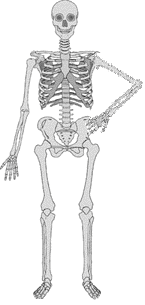

 |
Humans are build around
calcium deposits they seem to call bones. Collectively, the bones are called
the skeleton. Further in depth we learn there are two main parts to the
skeletal system; the axial and the appendicular skeleton. The axial, root
"axis", skeleton consists of the skull, hyoid bone, vertebral
column, the sternum, and the ribs. The appendicular skeleton includes the
bones of their extremeties, the pectoral girdle, and the pelvic girdle.
The skull encases the brain. It consists of many flat rounded bones fused together. The hyoid is a bone suspended behind the mandible (lower jaw). The vertebral column is divided into three groups; the spine, sacrum, and coccyx. The thoracic vertebrae have facets for ribs to connect to. The sternum is on the opposite side of the body as the vertebral column, it connects with the twelve pairs of ribs. The ribs are long, flat bones that protect the lungs, heart, and give the body shape. In the appendicular skeleton the upper extremeties, or the "arms", consist of the humerus, radius, carpals, metacarpals, and phalanges (in order from top to bottom). The pectoral girdle consists of two scapula and two clavicles (one of each on opposite sides of the body). The pelvic girdle is made of three bones (illiam, ischiam, and pubis) fused together to create the hip.The lower extremeties consist of the femur, patella, tibia, fibula, tarsals, metatarsals, and phalanges. Yellow and red bone marrow fill the bones. Yellow marrow is fatty connective tissue, while red marrow makes red blood cells, and most white blood cells. Bones are joined together at joints. There are three catagories of joints; freely movable(hinge, ball-and-socket, pivot, condyloid, plane, and saddle), slightly movable (synchondroses and symphyses), and immovable (sutures, syndesmoses, and gomphoses). Bones are held together by ligaments. |